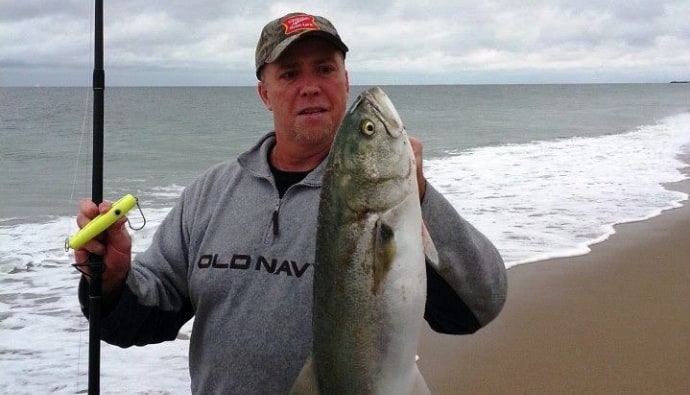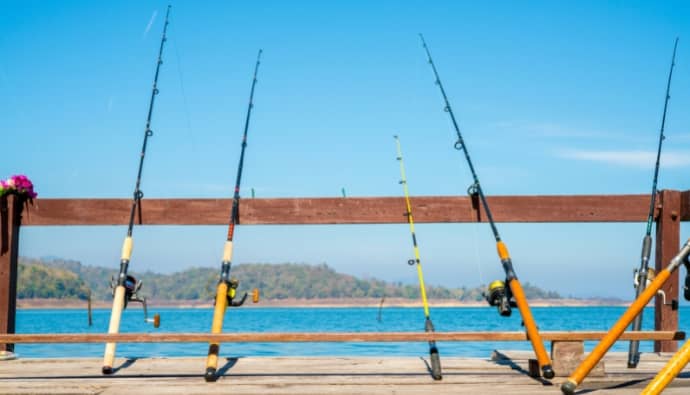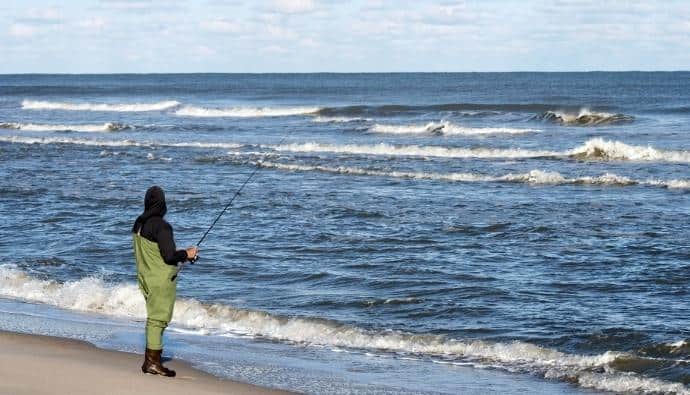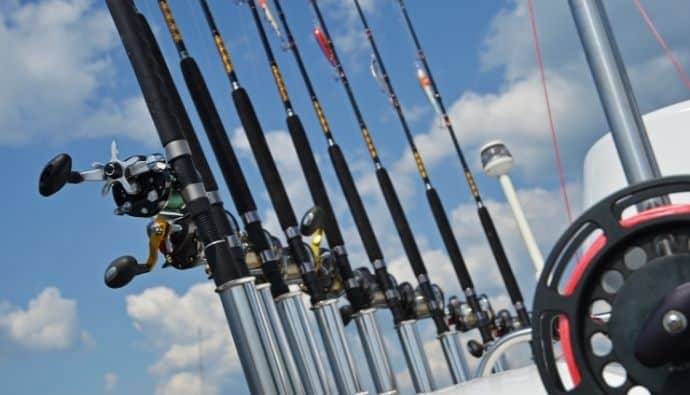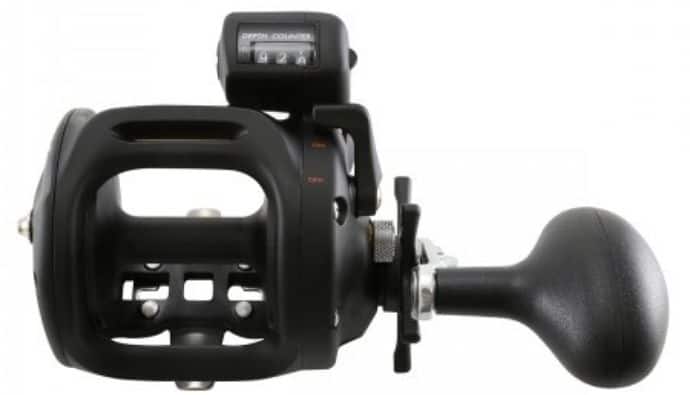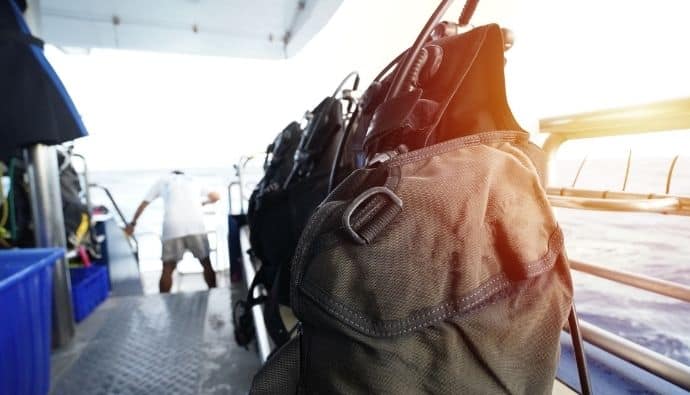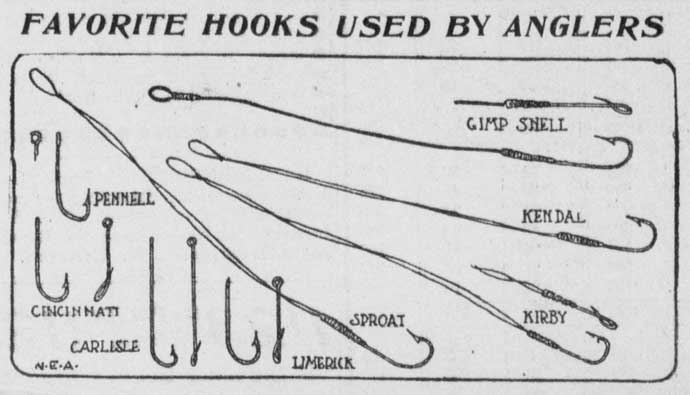In this article, we’ve aggregated the surf fishing gear you need to get started targeting fish in the surf.
Standard Surf Fishing Setup
- Surf fishing rods
- Surf fishing reel
- Fishing line
- Tackle: weights, hooks, bait, lures
- Surf fishing rigs
- Accessories: Fishing pliers, scissors, nail clippers
- Apparel: board shorts, sunglasses, backpack, fishing mask, sunscreen
- Fishing license
Surf Fishing Rods
If you decide you want to heave out a huge piece of bait far out into the ocean and wait for a fish to come by and take it, you’re going to want large surf fishing rods. This method requires a rod between 10 and 15 feet long.
This size rod will take some getting used to for casting, so your first few times might be unpleasant. Also, note that you’ll need to have plenty of space in front and behind you to cast it without having anything obstruct your action.
This size fishing rod tends to be a bit heavy, so you won’t be holding the rod for a long while waiting for the fish to bite. It’s better to place the pole in the sand or a holder or lean against a structure until the fish bite.
Looking for a quick pick surf rod to get started?
Catching Hard-to-Reach Fish
Depending on the structure of the beach, there might be a trough that drops from around three feet to, say, 20 feet. That’s usually where the larger fish are active, and that’s simply too far for a smaller pole to cast out there.
You’ll need to use heavy weights to be able to cast out far. With 3 ounces of lead, it’s not uncommon to cast it out 250 feet or more.
When using a big rod, it tends to be harder to feel when a smaller fish is on the line. This isn’t a big problem if you leave the rod in the ground and wait for a solid bite before reeling in.
It’s not uncommon to see videos of anglers pulling in massive sharks from the beach using large surf fishing rods.
If you’re interested in trying that out, ensure you get the appropriate line that can withstand their sharp teeth.

Light-Line Surf Rods
If you want to be more active in surf fishing, then you should try getting a medium to a short rod to hit the troughs where the fish are near shore.
If you don’t know how to spot troughs, you can try fan casting, throwing out in different areas up and down the beach to hit a place where fish are located.
For beginners who just want to get their feet wet, try these surf fishing rods:
- Length: 7 to 9 feet
- Power: Medium to medium-light
- Action: Fast
More on How to Pick the Best Surf Fishing Rods
Surf Fishing Reels
When you’re surf fishing, you’re going to be dealing with the harsh salt water and sand that will damage anything that moves…and since reels have moving parts, it’s essential to opt for quality.
The two styles of reels standard for surf fishing are:
- Spinning Reels
- Conventional Reels
Looking for a quick pick reel to get started?
Surf Fishing Spinning Reels
This is a typical reel style, especially for beginners who try to surf fish. They are easy to use and robust, depending on your brand and type.
The size of the reel you choose depends on the size of the fish you’re going after and the size of the rod you’re using.
Having a hard time with your reel? Learn how to use a spinning reel before getting one.
Spinning Reel Size Guide
- Small Spinning Reels
- Size: 1000 – 3500
- Suggested Mono: 2 – 10lb
- Suggested Braid: 4 – 20lb
- When to use: It’s good to use a smaller reel when surf fishing since you hold your rod and reel for long periods. Since you’re not casting super far with a short to medium-length pole, a small reel will have plenty of line for most fish you catch.
2. Medium Spinning Reels
- Size: 4000 – 5500
- Suggested Mono: 8 – 14lb
- Suggested Braid: 8 – 25lb
- When to use: These rods are great when you’re going for the larger fish and need a little more line than a smaller reel. These reels work well for surf fishing rods larger than 8 feet and can even be used for dropping a line off a kayak or small boat.
3. Large Spinning Reels
- Size: 6000 – 8500+
- Suggested Mono: 12 – 30 lb
- Suggested Braid: 12 -50 lb
- When to use: Large reels can be massive; however, for surf fishing, you probably won’t need anything more significant than 8500. These reels are enormous and will most likely be used for large poles where you must cast out far and put the pole in the sand while you wait for the big fish or shark to come by.
Surf Fishing Conventional Reels
Conventional reels are great for distance casting at the beach, especially if you want to go for a leopard shark or other big fish.
Conventional reels require you to lay down the line yourself using your finger, which can take some practice. Depending on the manufacturer, some come with a star wheel drag or lever drag.
The biggest challenge most new surf fishers have with conventional reels is their tendency to bird nest if you aren’t careful placing your thumb back on the spinning spool near the end of your cast. However, once you master this, you’ll be able to cast farther than a spinning reel due to the reduced drag design.
Some conventional reels come with magnetic brakes, which tend to be better than centrifugal brakes.
If you use a big surf fishing rod, it’s worth trying a conventional reel to get the most distance out of your casts.
More on How to Pick the Best Surf Fishing Reels
Surf Fishing Lines
There’s a host of fishing line setups for you to choose from, but the standard line options are braid and monofilament.
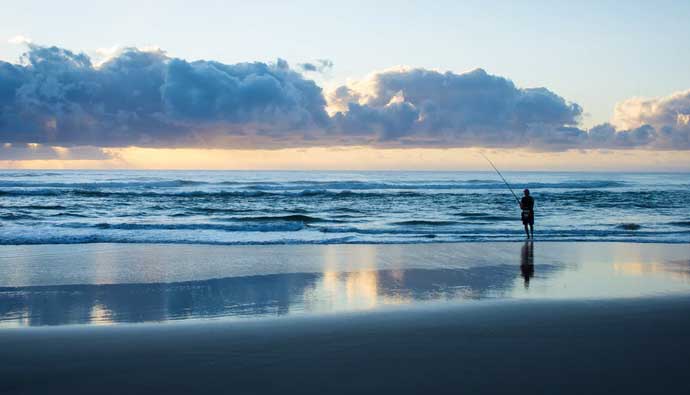
The essential items to consider when picking your line is:
- Price per yard
- Abrasion resistance
- Stretch
- Amount of line that can fit on your spool
Looking for a quick pick fishing line to get started?
Price
Mono tends to be cheaper than braid of the same breaking strength. Being expensive doesn’t mean braid is the clear winner; it depends on the application.
Abrasion Resistance
Mono is the clear winner. Anytime mono is rubbing against something sharp like a rock, it tends to wear but not snap instantly, unlike braid.
Stretch
Mono stretches more than braid. This is important if the fish you’ve hooked has a soft mouth, and you need some leeway during the fight to prevent the hook from pulling off.
Some anglers like braid for artificial lures since it doesn’t stretch, giving them the sensitivity and responsiveness they desire.
Line Diameter
Braid is significantly thinner than mono for the same breakage strength. This means you can spool more braid on a reel than with mono.
This is beneficial because you can use a smaller reel that weighs less and won’t make you tired after a long day of fishing.
Casting Diameter
Braid is thinner, which means you can cast them farther than mono. Some empirical tests show that braid gets at least 7% further cast than mono.
Braid Backing With Mono Topshot
The new trend in surf fishing is to braid back at least half your spool and top-shot the rest with mono.
This means you’ll be fishing primarily with the mono since you most likely won’t be using the entire length of your reel, but you have the security of knowing if you catch the big one, you have the line necessary to bring the fish in.
This is also helpful when you want to replace the cheaper mono and keep the braid on there since it’s barely used. This saves you money over the long haul, plus you get to use a smaller reel when otherwise you’d need a bigger one.
More on How to Pick the Best Fishing Line for Spinning Reels
Fluorocarbon Leaders
Many anglers like to use a fluorocarbon leader because they are ultra-clear and make it hard for fish to see the line. They also sink more aggressively than mono or braid, which is nice when trying to get your line below the waterline.
Fluorocarbon tends to be more expensive than mono as well.
More on How to Pick the Best Braided Fishing Line for Surf Fishing
Surf Fishing Tackle
Your tackle needs will differ depending on where you’re fishing and the conditions. Below are some general tackle items that should work for most surf fishers.
Looking for a quick pick saltwater lure to get started?
Sinkers
Regarding weights, different styles depend on how you want your bait to behave in the water.
Most anglers will use a 1 to 3-oz bullet, slip, or pyramid sinker to get their bait far beyond the breakers.
If you’re going for a halibut or want to get a fish’s attention, add a colored bead between the weight and the swivel. Red and orange tend to work well.
If you’re using a swimbait, check out the ½ and ¾ oz jig head weights that come with an integrated hook to hold the weight to the bait.
Hooks
You’ll want a bunch of different hooks depending on your setup needs. You should have at least ten of each size between 4 and 8.
Get different styles such as the mosquito, bait keepers, octopus, etc.
As for colors, red and black seem to do well, but I’ve caught on to pretty much all colors in the past.
More on How to Pick the Best Fishing Hooks
Soft Bait Lures
You can never have enough soft bait lures to test in your waters. I’ve had great success catching small- to medium-sized fish using Berkley GULP!
Camo Sandworms (2 inches) and Big Hammer Perch Grubs in Motor Oil Red Flake and Motor Oil Red Flake and Green colors.
Get a wide variety of colors and types to try out since it depends on the water conditions. If the area you’re fishing in is murky, then get dark-colored bait. If the area is bright and clear, then try some vibrant colors.
Hard Bait Lures
Certain species don’t go for the soft baits, which require you to spend some money on the hard baits.
Some hard baits that have worked well for me:
- Lucky Craft Flash Minnow 110
- Rapala Maxrap 13 (in Flake Hot Blue and Sardine colors)
- ⅝ oz Krocodile Spoons (in Green and Blue Mackerel colors)
- ¼ – 1 oz Kastmasters
More on the Names of Fishing Lures
Surf Fishing Rigs
Knowing how to rig a fishing line is essential, so you’re not stuck out on the beach looking like a beginner. One way to make it easy is to bring pre-made surf fishing rigs with you.
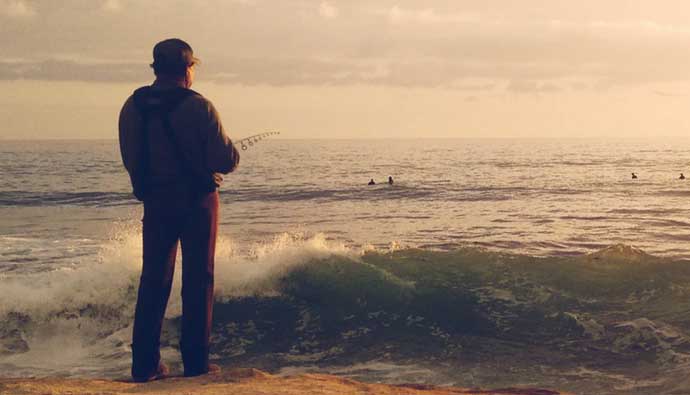
Carolina Rig
The most straightforward surf fishing rig is the Carolina Rig. It’s the setup for someone who wants to get out in the surf, get wet, and fan cast all over the place.
It’s comprised of a slip weight with an optional colored bead, swivel, leader, then a hook with an attached lure or bait. For most surf conditions, you’ll need a ½ oz weight, but feel free to opt for a ¾ or 1 oz if the waves are more significant.
The best bait for this setup to throw on your hook is a Gulp! 2-inch camo sandworm, Big Hammer perch Grub in Motor Oil Red Flake, or a live sand crab.
More on How to Pick the Best Surf Fishing Rig
Drop Shot Rig
This fishing rig is popular in Japan and uses a weight, hook, and lure in a specific configuration. Using a Palomar Knot.
Place a ¼ to 1oz weight at the end of your leader. Bell sinkers work well.
12 to 14 inches above the sinker, attach a hook using a Palomar knot. You can then place a soft lure that looks like a fish on the hook. Hook the other end of the leader line to your swivel, and you’re ready to go.
Keep your rod at 9 o’clock when you cast out, and hold the line tight. As you reel it in, move your rod between 9 and 12 o’clock to have the lure flutter up and down realistically.
Most of the time, a Carolina rig will get the job done, but sometimes if you’re having a hard time, you’ll need to spice it up, and this rig might just land you a Halibut. Worth a shot!
Surf Fishing Accessories
Now that we’ve covered all the essentials for surf fishing, it’s time to dive into the various nice-to-haves to make your life comfortable.
Most of these items are not needed for beginners until you spend more time in the water.
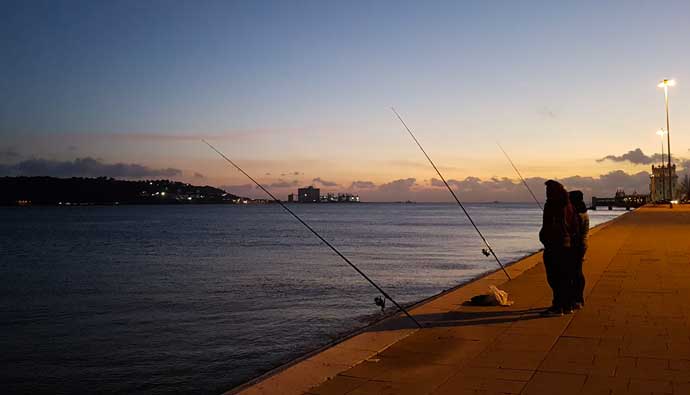
Sand Spike
Sand spikes are plastic, wood, or metal rod holders that you drive into the sand. If you’ve gone to the beach and seen a giant fishing pole pointed near vertical in the sand, it was most likely supported by a sand spike.
These come in handy to keep the line high up so that people can walk along the beach without being clotheslined by the fishing line. They also make it convenient while waiting for a fish to bite without your pole flying off toward the ocean.
Buckets
Buckets make great seats while waiting for the big ones to take your bait. If you’re fan-casting, it’s nice to have a bucket to throw the keeper fish in with some ice. This helps you not get all the fish juices inside your car.
Keeping them in a bucket is helpful if you’re using live bait, especially if you pick up a cheap aerator to oxygenate the water.
Fishing Backpack
It helps transport your gear from your car to the beach without needing to carry anything in your hands except your pole and bucket.
Looking for a quick pick-tackle bag to get started?
[amazon box=”B08Q7NN6KL”]
Key Features:
- Plano Tackle Storage
- Rust-free zipperless design
- High-performance TPE-coated waterproof fabric
- The gusseted top closes neatly and securely with buckles
Plano Z-Series Tackle Bags are the perfect way to store and organize your tackle. With five 3750 Stowaway Boxes included, this bag will keep everything neat while you’re on the go.
The Kryptek Raid/Blue design is perfect for any fishing enthusiast, and the no-slip molded bottom design keeps everything in place.
Its gusseted top closes neatly and securely with buckles, while the Plano-exclusive Utili-Tackle Rail System keeps everything within reach. This bag is a must-have for any angler, whether you’re headed to the lake or the river. And with a backpacking fishing rod in tow, you can easily move around from one fishing spot to the next.
More on How to Pick the Best Fishing Backpacks and Tackle Bags
Fishing Pliers
Looking for a quick pick fishing plier to get started?
[amazon box=”B01LYGPNW6″]
Key Features:
- DIMENSIONS: 7.5” overall length with 2” jaws
- You can quickly remove or replace hooks
- Rust resistant
- A sheath with a belt loop for close hands-free carry
Nothing makes you feel guiltier than having a fish swallow a hook, and you can’t remove it because you don’t have pliers to get leverage on the point of the hook. Pliers help remove hooks easily and are a must-have for the ethical angler.
Bubba Blade 7.5 Inch Fishing Pliers with Stainless Steel Jaws are the perfect tool for any fisherman. With their quick hook removal and rust-resistant design, these pliers are a necessity for anyone who loves to fish.
The Ti-Nitride coating makes them extra durable, while the Non-Slip Grip handle ensures you have a firm grip on them at all times. The included sheath has a belt loop for close, hands-free carry.
Made of aerospace aluminum, construction makes them light and easy to carry. Whether you’re an experienced fisherman or just starting, these pliers are a must-have for anyone who loves to fish.
Measuring Tape
Measuring tapes are handy for measuring your fish after it’s been caught. If you want to keep your fish, it must be of the legal limit, and without a measuring tape, you’d never know.
Even if you catch and release, measure your fish to keep track of the biggest ones you’ve caught of each species.
Fingernail Clippers
These come in handy to cut lines, especially when removing the excess line around a knot. Some surf fishing anglers opt to use their teeth…however, these are more effective.
Tackle Containers/Dividers
Pick up a cheap clear container with dividers to store your tackle. This helps you keep it organized and easy to access when you need to swap out or replace your rigging.
A common way to organize is to have three small containers, one for your soft lure packages, another for your various hooks, weights, leaders, etc., and a final one for your hard baits.
If possible, get different colors to help you easily identify each container in your backpack.
Hand Towel
Sometimes rinsing your hands in the ocean after catching a fish can’t get all the slime off. If you have a cheap old towel, it’ll help get your hands dry and slime-free so you can get back after it.
Just note, don’t hold the fish with a towel since it’ll remove their natural slime and could lead to disease or illness for the fish.
Camera
Fishing is better when shared. If you catch something, sharing a picture or video with your friends is always an enjoyable experience.
I like using a GoPro, but most smartphones are more than adequate for capturing awesome pictures.
More on How to Pick the Best Fishing Camera
Sunglasses
If you’re going to be out mid to late afternoon, it’s helpful to have a pair of sunglasses, so you don’t stare directly into the sun without UV protection.
Polarized lenses are great for reducing glare out on the water.
Sun Protection
Make sure you wear ample sunscreen and apply it liberally if you’re going out during the day. You don’t need to get unnecessary wrinkles from the sun.
Looking for a quick pick fishing mask to get started?
[amazon box=”B07YSC2Q3N”]
Key Features:
- Multi-functional breathable seamless microfiber
- Fishing sun mask
- Headwear, neck gaiter, beanie, balaclava
- Moisture-wicking
- UPF 50 sun protection
The Fishing Mask Camo Headwear (or a quality sun hat) is the perfect way to protect yourself from the sun while fishing. These wrap around your face and protect you from the sun and even the wind. Windburn is real and can leave your face red and in pain!
Made of multi-functional breathable seamless microfiber, this mask is perfect for any fishing enthusiast. The UPF 50 sun protection ensures you stay safe and protected from the sun’s harmful rays, while the moisture-wicking design keeps you cool and comfortable all day long.
This mask can also be worn as headwear, neck gaiter, beanie, or balaclava. When you’re not out fishing, this mask makes a great addition to any outdoor enthusiast’s wardrobe. If you’re hiking, biking, or just enjoying the outdoors, this mask is a must-have for anyone who loves to be outdoors.
More on How to Pick the Best Fishing Hats
Food & Water
If you’re going to be out for more than a few hours, do yourself a favor and bring some snacks and water to stay hydrated.
Fishing License
Ensure you have the proper fishing license and ocean stamp for your state or country. No need to get in trouble doing something fun!
If you’re in the States, pick up your fishing license here.
As the waves crash on your legs, you feel the tip of your rod starts to quiver.
And you’re on!
Is it a ray? Could it be a shark? Maybe it’s a halibut?! The excitement is almost too much to handle as you reel it in fast.
It’s a surf perch…Well, at least you got a bite! Send it back and keep the casts flowing.
Listen to this post on the Cast & Spear Podcast
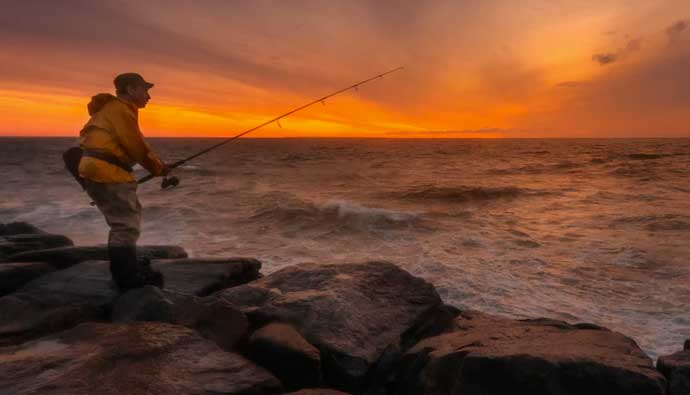
Frequently Asked Questions
Surf fishing is when you’re fishing in the surf zone. This could be from the rocks, reefs, or other structures. You’re looking for underwater structures and currents to present lures or bait to entice fish to bite.
It depends on what you’re targeting and what bait you’re using. Small fish will likely use around a size 6, and big fish like sharks can use 5/0 or larger.
A surf rod is used to get your bait or lure to the right zone. It’s also used to help fight the fish so you can tire them out and reel them into shore. Rods range from 7-15 feet, depending on your required casting distance.
It depends on what you’re targeting. Big fish have been brought in on spinning sizes 4500-5000 with 60-pound braid. Conventionals are often used for sharks and tend to be large to give you an extra line. Light-line surf fishing usually uses 2500-3000 spinning reels.
It depends on what you’re targeting. Whenever possible, use live bait. Cut bait work and is improved with bait elastics. If it’s allowed, be sure to chum the water to wake up the reef.
It depends on what you’re targeting. If you’re getting started with small fish, opt for 7-9 feet. If you need distance, go for 12-15 feet.
If you’re going for small fish, go for a 6-12 pound mono or 30-pound braid.
If you’re going for bigger fish, bump it up to a 60-pound braid, a shock leader, and a leader.
A shock leader is a thicker section of a leader that takes the initial casting force.
For light-line sure fishing, try a Carolina rig with a 1/2 ounce egg sinker, bead, swivel, and number 6 hook.
For a bigger game, try a pulley rig. When in doubt, try pre-made rigs, then learn to make your own.
Shrimp, squid, and cut fish make great bait.
Make sure you have all the required legal documents, rod, reel, tackle, sun protection, and hydration.
We like a good quality braid like J-Braid. For mono, we like Andes. And for fluorocarbon, we like Seaguar blue.
It depends on what you’re targeting. Keep it simple with mono first, then adventure into braid and fluoro where required.
Keep it less than 2 ounces if fishing close to shore. Check your rod specs if you’re casting out far.
There are tons of options, but we like the Breakaway Tackle LDX or HDX with a Diawa 4500 spooled with a 60-pound braid.

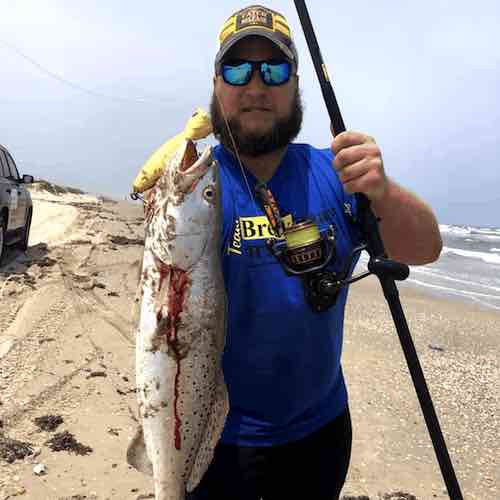



 Facebook
Facebook YouTube
YouTube
